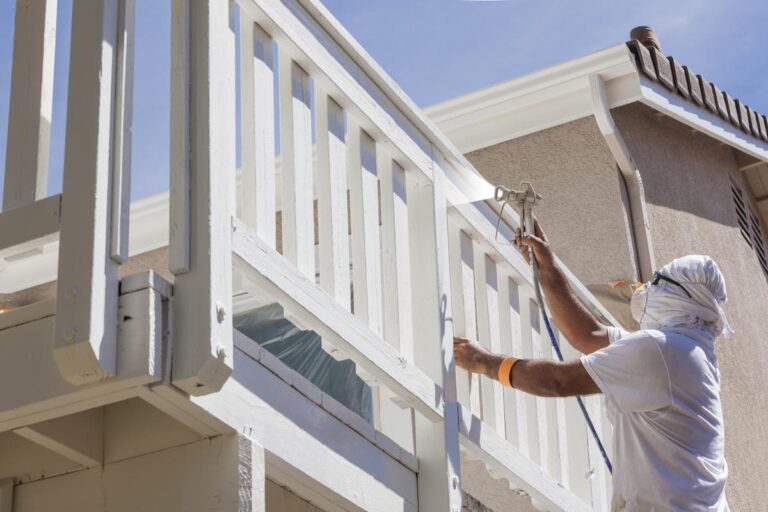Painting the exterior of your home is one of the best ways to refresh its look and protect it from weather damage. But before you buy paint, one of the most important questions to ask is: how much paint will you actually need? Knowing the right amount saves money, prevents waste, and ensures a smooth painting process.
In this guide, we’ll walk through how to calculate paint needs for a 2,000 sq ft house, what factors affect the amount, and a few tips to get accurate results.
Understanding Square Footage vs. Paintable Area
When someone says they have a “2,000 sq ft house,” they usually mean the floor area inside. However, this is not the same as the paintable exterior surface. The outside walls typically cover more square footage than the home’s interior footprint due to height, overhangs, and architectural details.
For a single-story home with a simple design, the exterior wall surface might be around 1.5 times the floor space—about 3,000 sq ft of wall area. A two-story house could easily have 4,000 sq ft or more of paintable surface.
General Paint Coverage Estimates
Most exterior paints cover 250–350 square feet per gallon on smooth surfaces. Rougher textures like stucco or wood shingles will require more paint—closer to 200–250 sq ft per gallon.
Here’s a quick estimate for a 2,000 sq ft home:
- Smooth siding: About 9–12 gallons for one coat.
- Rough surface (stucco, brick, textured wood): About 12–16 gallons for one coat.
- Two coats (recommended for durability): Double the above amounts.
This means you might need 18–24 gallons for smooth siding or 24–32 gallons for textured surfaces when applying two coats.
Other Factors That Affect Paint Usage
Besides surface area, several factors can increase or decrease the amount of paint you’ll need:
- Number of coats – Two coats provide better coverage, color depth, and weather resistance.
- Paint color change – Going from dark to light (or vice versa) often requires more coats.
- Type of paint – Premium paints often cover better, reducing the number of gallons needed.
- Surface condition – New wood, bare stucco, or unpainted siding will absorb more paint and may require a primer coat.
- Application method – Spraying uses more paint than brushing or rolling, though it’s faster for large surfaces.
If you want more precise planning, some local professionals offer free consultations to measure and estimate exactly how much paint your home will require. For example, Interior & Exterior Painting Services in Lenexa, KS often include these assessments as part of their service.
How to Calculate Your Paint Needs Step-by-Step
If you want a DIY estimate:
- Measure the perimeter of your house.
- Multiply by the height from the base to the roofline (exclude gable peaks for now).
- Add gable ends – Measure the width and height of each gable and multiply, then divide by two to get the triangular area.
- Subtract windows and doors – These don’t require paint, so subtract their total area from your calculations.
- Use the paint coverage rate – Divide the final paintable surface area by the coverage per gallon listed on your paint can.
For example:
- Perimeter = 160 ft
- Wall height = 20 ft → 3,200 sq ft
- Gables total = 400 sq ft
- Subtract 200 sq ft for windows and doors
- Paintable area = 3,400 sq ft
- At 300 sq ft/gallon → ~12 gallons per coat
Why Accuracy Matters
Overbuying means leftover paint that may never be used, while underbuying can cause delays if you run out mid-project. Paint batches can have slight color variations, so buying everything at once ensures consistency across your entire home.
A detailed calculation also helps you budget realistically—not just for the paint, but also for primers, brushes, rollers, drop cloths, and ladders.
While many homeowners enjoy tackling exterior painting themselves, there’s no denying the benefits of hiring an experienced crew. Professionals have the tools, techniques, and time to complete the job efficiently. For instance, homeowners in the Kansas City area often mention Prime Construction KC as a reliable option when discussing trusted local contractors for exterior projects. They’ve earned a reputation for thorough prep work, attention to detail, and lasting results—qualities that can save you money in the long run by avoiding frequent repaints.
Paint Buying Tips
- Always round up to the nearest gallon—better to have a little extra for touch-ups.
- Choose high-quality paint for better coverage and durability, especially in areas with harsh weather.
- Consider primer if painting over bare surfaces or making a dramatic color change.
- Store leftovers properly in a cool, dry place for future touch-ups.
Estimating Paint for Trim and Doors
Don’t forget your trim, doors, and shutters. These areas often need a different type of paint for durability and style. A gallon is usually more than enough for trim and doors on a 2,000 sq ft house, but the exact amount depends on the design and number of features.
When to Repaint
Most exterior paint jobs last 7–10 years depending on climate, surface preparation, and paint quality. Signs you need to repaint include peeling, fading, cracking, or chalky residue on the walls. Staying on top of maintenance helps avoid costly repairs down the road.
Conclusion
For a 2,000 sq ft house, expect to need around 18–32 gallons of paint for two coats, depending on your siding type, application method, and surface condition. Careful measurement and planning will ensure you buy the right amount and get the best results. Whether you take the DIY route or hire professionals, using quality paint and proper techniques will keep your home looking fresh for years.


